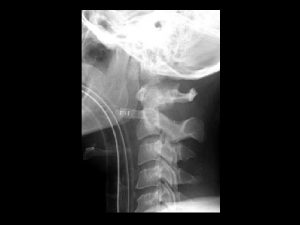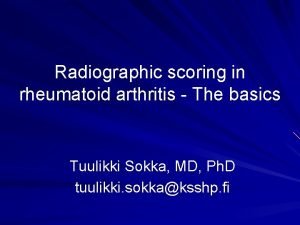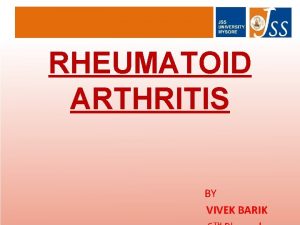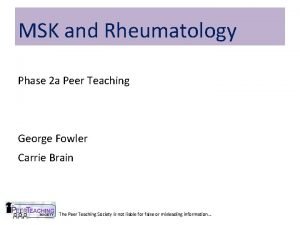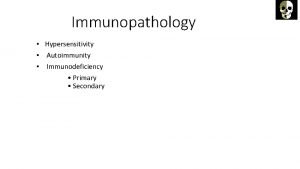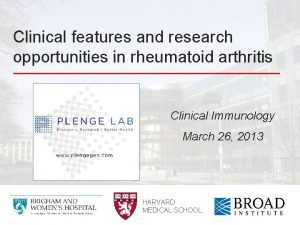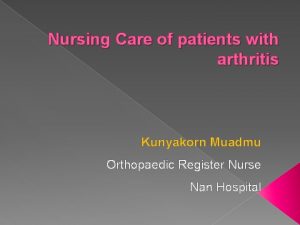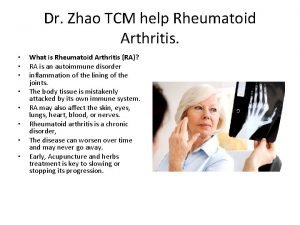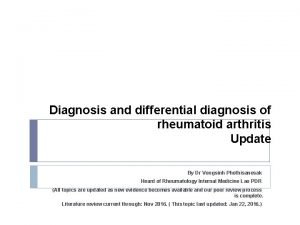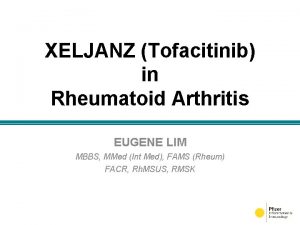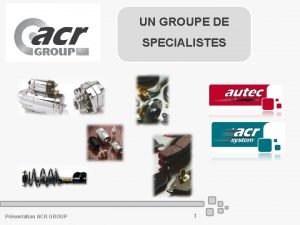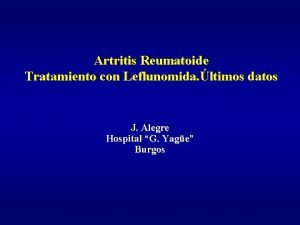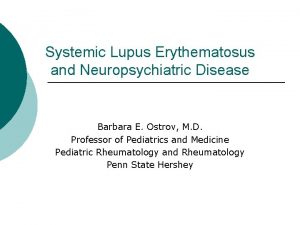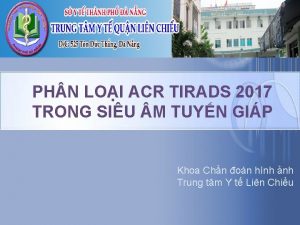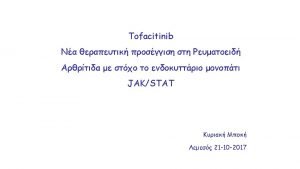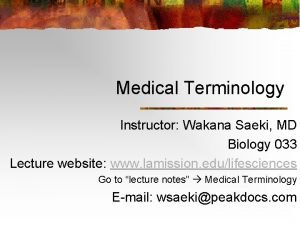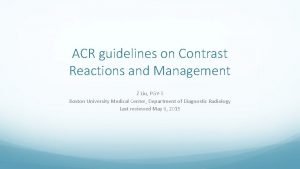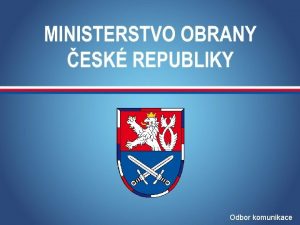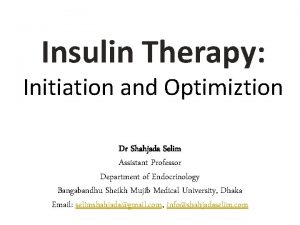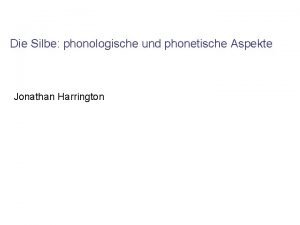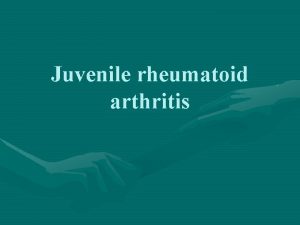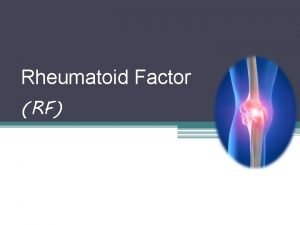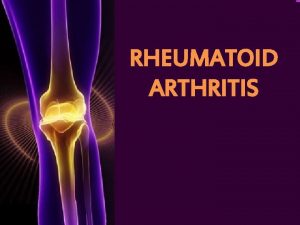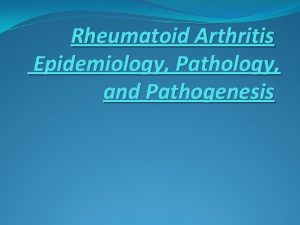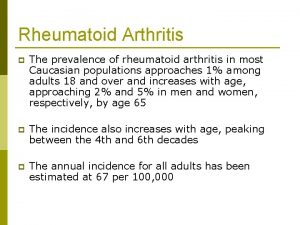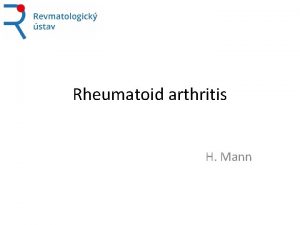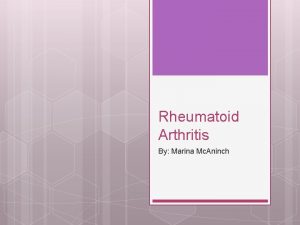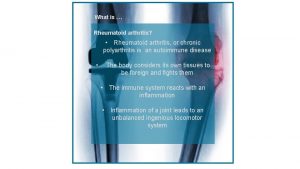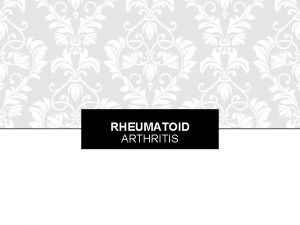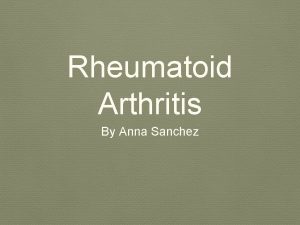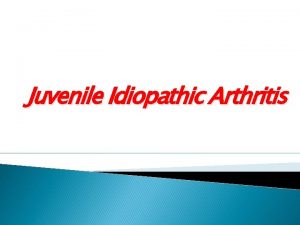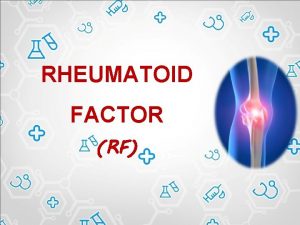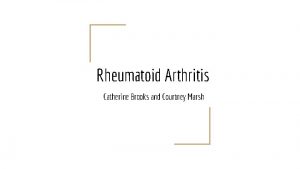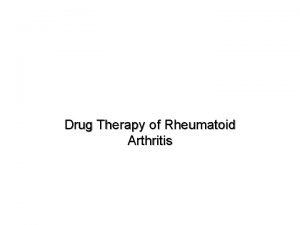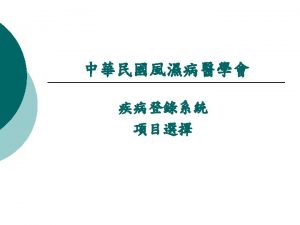Juvenile Rheumatoid Arthritis ACR criteria Age at onset





































- Slides: 37

Juvenile Rheumatoid Arthritis

ACR criteria • • Age at onset <16 year Arthritis in one or more joints Duration 6 wks or longer Onset type defined by type of disease in first 6 months – Polyarthritis: 5 or more inflamed joints – Oligoarthritis: <5 inflamed joints – Systemic: arthritis with characteristic fever • Exclusion of other forms of juvenile arthritis

Risk factors – Cause is multifactorial in people with genetic susceptibility – HLA DRB 1 are associated, – Possible infective aetiology (mycobacterium, bacterial or; viral infection and abnormal immunoregulation) – Onset is more common in winter

Etiology • Unknown • Two events are necessary – Immunogenetic susceptibility – Environmental trigger

Pathogenesis – Believed that RA is an autoimmune disease triggered by exposure of a genetically susceptible host to an unknown arthritogenic antigen. Autoimmune reaction Activation of CD 4 +T cells and lymphocytes and the release of inflammatory mediators and cytokines Destroy the joints

Cont. . • Pathogenesis of the disease depends upon : – The nature of the autoimmune reaction – The mediators of tissue injury – Genetic susceptibility – The arthritogenic antigen (s)

The nature of the autoimmune reaction • Activated CD 4+ Tcells and B lymphocytes Produce Cytokines Increase immune complex deposition Joint destruction

The mediators of tissue injury : cytokines play an important role Cytokines ( TNF and IL-1) stimulates Synovial cells Produce by macrophages and synovial lining cells that are activated by the T – cells in the joints Activates Various mediators of inflammation (PG ) and Matrix metalloprotineases (cartilage destruction) Osteoclasts Promotes Bone destruction Progressive joint damage

Synovium ( hyperplastic ) Rich in inflammatory cells becomes adherent to and grows over the articular surface , forming a Pannus - an inflammatory exudate overlying the synovial cells on the inside of a joint stimulates Release of IL-1 , platelet – derived growth factor Prostaglandin Cause cartilage destruction and bone erosion


Cont. . • Genetic susceptibility ( HLA) • Arthritogenic antigen : – No firm evidence has definitively identified a microbial organism as an etiologic agent

Clinical features • Morning stiffness, easy fatigability particularly after school, joint pain later in the day, joint swelling, warm, lacks of full range of motion. • Large joints are affected (knees, ankles, elbows and wrists Three major types of onset are described according to the presentation during the first 6 months of the disease, – Pauciarticular (four or fewer joints involved) – Polyarticular (5 or more joints involved) – Systemic (with fever and rash)

Pauciarticular • 4 or less joints (usually large) involved in 1 st 6 months of disease in asymmetrical fashion. • Commonest type 60% of affected children • Joint swelling is common than joint pain Two subtypes : - Type I (common) – Age : 3 – 5 years (girls) – Commonly affected sites : knees, ankle and elbow – Iridocyclitis (25%) Type II – Age : older than 8 years – Commonly affected sites : large joints of lower extrimities

Note : significant suprapatellar swelling (effusion)

Polyarticular • Occurs in 30% of patients • Common in girls • >5/= both large and small joints involved within the first 6 months of onset • Joint pain is common than joint swelling Two subtypes: Rheumatoid factor positive: • Onset : late childhood or early adolescence • Joints involved: small joints of the hand (MCP and first interphalangeal joints) • Presence of rheumatoid nodules • Uveitis (5%) Rheumatoid factor negative: • Onset : at any age • Joints involved : knees, wrists and hip • Rheumatoid nodules absent

Systemic onset • 10 % of affected children • Younger age : median age 4 years • Systemic features precede weeks or months before articular manifestations • Prominent visceral involvementhepatospleenomegaly, lymphadenopathy, serositis as pericardial effusion • Characterized by intermittent fever with daily peak of high temp (40 degree), with a characteristic twice daily peak for minimum of 2 weeks

Fever chart showing typical "quotidian temperature" of systemic onset JIA. The fever typically occurs twice a day, with spikes > 39°C, coming down to below baseline .

Cont… • Each febrile episode is accompanied by faint erythematous maculopapular rash (2 -5 mm) with central clearing and more prominent over trunk (common) and proximal extremities • Koebner phenomena- cutaneous hypersensitivity to superficial trauma


Investigations • Blood – Elevated WBC and platelet count – normocytic normochromic • Both +ve in acute and systemic onset CRP/ESR • Useful for following therapeutic efficacy, • Indicator of inflammatory response – Elevated ANA • In 40 -85% , unusual with systemic onset • Associated with increased risk of chronic uveitis

Radiology: – – – – Show soft tissue swelling, periarticular osteopenia, loss of joint space, erosions Deformity Radial deviation of the wrist Ulnar deviation of the fingers – Swan neck deformity ( flexon – hyperextension deformity ).

. • Fusion of the upper cervical apophyseal joints is the most characteristic change in cervical spine • Atlantoaxial subluxation is a potential complication of this involvement.

Complications • Articular – Flexion contractures – Overgrowth problems - scolosis, • Extra articular – Uveitis • Incidence 10% • Highest risk in 1 st 4 year of arthritis: in 5% before arthritis • Common in ANA +ve : 90% uveitis ANA +ve • Treat with topical steroid. if toxicity or not responding start methotrexate

inflammation (chronic anterior uveitis). Note the weblike attachments of the pupillary margin to the anterior lens capsule of the right eye.

– Impaired growth : steroid/disease – Osteoporosis • Steroid therapy

Management • Goals – Decrease chronic joint pain and inflammatory process – Establish the child in a pattern of adaptation that is as normal as posssible – Minimal adverse effect of drugs – Normal growth and development

Cont. . • Principles – It is a multidisciplinary approach involving different specialities- physiotherapist, occupational therapist, orthotists, nurses, psychologist, social worker , orthopedic surgeon, GP, pain management team – Treatment is prolonged for many years – Begin with simplest, safest and most conservative methods. If this is inadequate choose other agents in orderly fashion

Management of juvenile Rheumatoid Arthritis • Early aggressive suppression of inflammation is the principle underlying treatment • Recent changes – Increased use of intra articular and IV steroid – Establishment of methotrexate as first line DMRD – Biological and newer treatment for resistant diseases

Cont. . • NSAID – Mainstay – COX 1 inhibitors- naproxen, ibuprofen, indomethacin, diclofenac piroxicam – COX 2 inhibitors- rofecoxib, valdecoxib: have less GI symptoms: not been fully evaluated in children – Treatment must continue for at least 2 -3 mo before decision to switch over to other NSAID

DMRD • Methotrexate – Highest response rate 60 -80%) , less with systemic onset – 15 -20 mg/m 2/week – Adverse effects: 13% have GI symptoms, liver toxicity (serum transaminase and albumin every 4 -8 wks), nausea , vomiting , mouth ulcers, loss of appetite, alopecia, leucopenia

• Sulfasalazine • Other DMRD – Double blind placebo controlled study failed to show efficacy of penicillamine, hydroxychloroquine, gold

GLUCOCORTICOIDS. • Prednisolone 1 -2 mg/kg: severe unremitting arthritis, systemic manifestations (pericarditis, myocarditis, ), and rapidly progressive disease • Often combined with NSAID or others • Ophthalmic steroid for treatment of chronic uveitis.

Other aspects • Opthalmic check up – Girls <6 years with ANA positive pauciarticular arthritis screened for uveitis at 3 -6 months interval – Other forms once at the time of diagnosis and annually thereafter • Dietary evaluation and counseling to ensure adequate calcium intake • Physical and occupational therapy

JRA differs from RA – Oligoarthritis is more common (poly arthritis) – Systemic onset is more frequent – Large joints are affected – Rheumatoid nodule and RF are usually absent – ANA seropositivity is common

D/D Acute arthritis (<2 weeks) : – Acute rheumatic fever – Transient synovitis (2 -4 days, aspiration) – HSP – Septic arthritis – Trauma

Cont… Subacute arthritis (2 – 6 weeks) : – Reactive arthritis (asymmetrical joint involvment of lower limbs) – Bone pains associate with leukemia – Hemarthrosis

Cont… Chronic arthritis (>6 weeks) : – JRA – Tubercular arthritis (monoarthritis of hip or ankle, tuerculin test strongly positive) – Psoriatic arthritis (typical rash, family history of psoriasis)
 Polyarticular arthritis
Polyarticular arthritis Fibula fractire
Fibula fractire Diagnosing rheumatoid arthritis
Diagnosing rheumatoid arthritis Caplan syndrome
Caplan syndrome Steinbrocker stage rheumatoid arthritis
Steinbrocker stage rheumatoid arthritis Pathology of rheumatoid arthritis
Pathology of rheumatoid arthritis Nail pitting
Nail pitting Arthritis care plan ppt
Arthritis care plan ppt Rheumatoid arthritis side effects
Rheumatoid arthritis side effects B t cells
B t cells Abatacept
Abatacept Nursing diagnosis for rheumatoid arthritis
Nursing diagnosis for rheumatoid arthritis Difference between rheumatoid arthritis and osteoarthritis
Difference between rheumatoid arthritis and osteoarthritis Rheumatoid arthritis
Rheumatoid arthritis Ocular sign
Ocular sign Eular criteria
Eular criteria Iron age dates
Iron age dates Iron age bronze age stone age timeline
Iron age bronze age stone age timeline Rheumatoid factor range
Rheumatoid factor range Acrsystem
Acrsystem Criterios acr
Criterios acr Acr format resume
Acr format resume Bella è l'acr
Bella è l'acr Hani abujudeh
Hani abujudeh What is mean by minor
What is mean by minor Serositis
Serositis Lsa career fair
Lsa career fair Tirads 2017
Tirads 2017 Devacizumab
Devacizumab Medical terminology instructor
Medical terminology instructor Acr contrast premedication
Acr contrast premedication Długość toru transmisyjnego
Długość toru transmisyjnego Barety ačr barvy
Barety ačr barvy Onset and coda examples
Onset and coda examples Voice onset time
Voice onset time Ambisilbisch
Ambisilbisch Diabetes insulin chart
Diabetes insulin chart Lenisierung beispiel
Lenisierung beispiel

